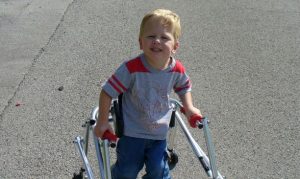What is Spastic Cerebral Palsy?
Spastic cerebral palsy is said to affect approximately 70-80% of all children born with cerebral palsy. Spasticity usually manifests itself in stiff muscle tone, meaning that the child will find it difficult to move and will suffer from stiff, awkward and jerky movements.

Spastic Cerebral Palsy
Children with severe spastic CP often require the use of wheelchairs and/or crutches due to their limited range of movement.
Spastic cerebral palsy can be further-specified based on affect it has on a child’s limbs:
- Hemiplegic Spasticity – This presents itself as limb stiffness on one side of the body.
- Quadriplegic Spasticity – All four limbs are affected by muscle stiffness.
- Spastic Diplegia – Affects only both legs (or both arms).
- Spastic Monoplegia – Affects only one limb.
- Spastic Triplegia – Three limbs are affected by muscle stiffness.
Signs of Spastic Cerebral Palsy
- Abnormal reflexes such as holding on to items for prolonged periods of time, and being unable to let go until the item is pried out of their hands.
- Exaggerated movements such as trying so hard to place one foot after the other in a forceful and unnatural manner.
- Tight and stiff muscles which can be felt when one touches the child. They may also have a stiff and stationary facial expression, and their legs or arms may cross together most of the time.
Spasticity may also show up in speech. If your child is slow when it comes to stringing together words to make a sentence, or if he or she slurs a lot of the time, this could be brought on by spastic cerebral palsy. In addition, if they seem to have a tight or hoarse voice, they may have tight vocal cord muscles brought on by spastic CP as well.
What Causes Spastic Cerebral Palsy?
- Injuries during the birthing process may cause bilirubin levels to rise; this is the body’s response to any kind of trauma. This is usually released when there is an injury in the body, and is an attempt by the body to resolve bleeding. That said, the undeveloped baby’s body cannot properly excrete bilirubin, making it build up to dangerous levels in the brain, causing damage to motor areas.
- A birth injury may cause internal hemorrhaging, which if not caught in a timely manner will cause blood to rush to different areas of the baby’s body including the brain, ultimately leading to cell death.
- While prenatal infections such as meningitis and encephalitis can cause cerebral palsy, this is 100% avoidable if a prenatal nurse does their due diligence and schedules regular checks. If these infections occur and are not dealt with quickly, they usually spread to the child’s brain, causing cerebral palsy.
While there is no cure for spastic cerebral palsy, adjunctive treatments such as physical therapy may help with modulating muscle tone so the child can move around with little to moderate help. Surgeries such as SEMLARASS have also shown promise if done before a certain age. Speech and occupational therapy, as well as physical therapy, all have a role in helping spastic cerebral palsy children better-communicate and achieve normalcy.
